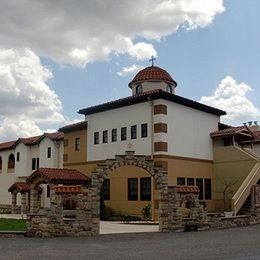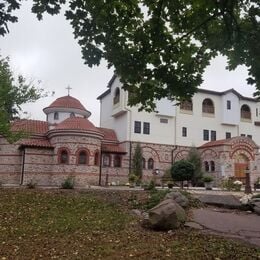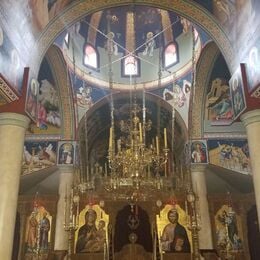Denomination: Orthodox Church
Holy Protection Monastery is an institution affiliated with the Greek Orthodox Archdiocese of America, Diocese of Pittsburgh, under the ecclesiastical authority of the Ecumenical Patriarchate of Constantinople, founded by the Apostle Andrew in 37 A.D, confessing the Nicene Creed and faith in the One, Holy, Consubstantial, Undivided, and Life-Creating Trinity, in accordance with the Seven Holy Ecumenical Councils, and faithfully preserving the Sacred Holy Tradition as passed down from the Apostles.
Holy Protection Greek Orthodox Monastery was founded in 1993 by Elder Ephraim, former Abbot of Philotheou Monastery on Mount Athos who also founded 16 other monasteries throughout the United States and Canada. The Monastery’s “Mother House” is the Archangel Michael Monastery on the island of Thasos in Greece.
The site of the Monastery is on a mountain overlooking the Lehigh River Valley in the Pocono Mountains region of Pennsylvania. A white cross can be seen on the top of the Monastery’s mountain from interstate route 80. The construction of the Monastery’s present facilities began in 2001. These facilities include: the main building with the monastic cells; the main church dedicated to the Holy Apostles Peter & Paul; and two chapels dedicated to St. Nektarios and St. Paraskevi. Other buildings include: a bakery, a workshop with an icon-painting studio, a woodworking shop, a candle making shop and a guesthouse. The Sisters maintain their own gardens, greenhouse and fruit orchards.
The monastery follows the ancient “coenobitic,” (i.e. common) way of monastic life, consisting of common meals, common prayer and church services, common work and rest periods. The members of the Sisterhood are united through solidarity in their struggle in Christ under the spiritual guidance and obedience to the mother abbess Gerontissa Olympiada and to their spiritual father Elder Ephraim.
The daily program begins at midnight with keeping vigil with prayer and spiritual reading, followed the first daily Church service. After a rest period and breakfast, the Sisters begin their work day until evening when they retreat to their cell for rest.
The purpose of the monastic life is attaining to the Kingdom of Heaven. All activities in which monastics engage, whether spiritual or material have this as their final aim. Monasticism is also called “the angelic way of life” because having renounced the world all therein, monastics dedicate their life entirely to God, imitating the angels in their virtues and conduct. However, since monastics, as human beings, have a dual nature of both flesh and spirit, their activities serve both of these aspects. Thus, their life is one of both prayer and labor. It is through constant prayer that the sisters nourish their soul, and through the work of their hands that they support themselves through various chores and crafts.
Prayer is a monastic’s constant companion during night and day. Whether they work or rest, monastics try to keep their attention focused on the name of the Saviour through the Jesus prayer. In the community of Holy Protection Monastery, this is also the teaching received from Elder Ephraim who spent the first years of his monastic life close to one of the greatest teachers of noetic prayer of 20th century – Elder Joseph the Hesychast. It is from Elder Joseph that Elder Ephraim himself received the teaching about the practice and theory of the Jesus prayer. According to this teaching, through the constant invocation of the name of Jesus, in the form of “Lord Jesus Christ have mercy on me,” can someone attain to theosis -- the union with God.
Holy Protection Greek Orthodox Monastery was founded in 1993 by Elder Ephraim, former Abbot of Philotheou Monastery on Mount Athos who also founded 16 other monasteries throughout the United States and Canada. The Monastery’s “Mother House” is the Archangel Michael Monastery on the island of Thasos in Greece.
The site of the Monastery is on a mountain overlooking the Lehigh River Valley in the Pocono Mountains region of Pennsylvania. A white cross can be seen on the top of the Monastery’s mountain from interstate route 80. The construction of the Monastery’s present facilities began in 2001. These facilities include: the main building with the monastic cells; the main church dedicated to the Holy Apostles Peter & Paul; and two chapels dedicated to St. Nektarios and St. Paraskevi. Other buildings include: a bakery, a workshop with an icon-painting studio, a woodworking shop, a candle making shop and a guesthouse. The Sisters maintain their own gardens, greenhouse and fruit orchards.
The monastery follows the ancient “coenobitic,” (i.e. common) way of monastic life, consisting of common meals, common prayer and church services, common work and rest periods. The members of the Sisterhood are united through solidarity in their struggle in Christ under the spiritual guidance and obedience to the mother abbess Gerontissa Olympiada and to their spiritual father Elder Ephraim.
The daily program begins at midnight with keeping vigil with prayer and spiritual reading, followed the first daily Church service. After a rest period and breakfast, the Sisters begin their work day until evening when they retreat to their cell for rest.
The purpose of the monastic life is attaining to the Kingdom of Heaven. All activities in which monastics engage, whether spiritual or material have this as their final aim. Monasticism is also called “the angelic way of life” because having renounced the world all therein, monastics dedicate their life entirely to God, imitating the angels in their virtues and conduct. However, since monastics, as human beings, have a dual nature of both flesh and spirit, their activities serve both of these aspects. Thus, their life is one of both prayer and labor. It is through constant prayer that the sisters nourish their soul, and through the work of their hands that they support themselves through various chores and crafts.
Prayer is a monastic’s constant companion during night and day. Whether they work or rest, monastics try to keep their attention focused on the name of the Saviour through the Jesus prayer. In the community of Holy Protection Monastery, this is also the teaching received from Elder Ephraim who spent the first years of his monastic life close to one of the greatest teachers of noetic prayer of 20th century – Elder Joseph the Hesychast. It is from Elder Joseph that Elder Ephraim himself received the teaching about the practice and theory of the Jesus prayer. According to this teaching, through the constant invocation of the name of Jesus, in the form of “Lord Jesus Christ have mercy on me,” can someone attain to theosis -- the union with God.





